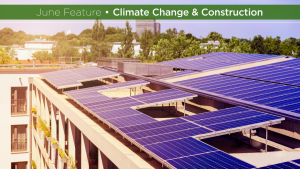Another new year dawns without an updated 2020 National Building Code. However, there are signs of movement in terms of federal accountability.
On Dec. 16, Prime Minister Justin Trudeau issued a ministerial mandate letter to Jonathan Wilkinson, the minster of natural resources, effective last October. It’s a long menu of initiatives expected from the ministry during the government’s next period in office. The good news for Canadians looking for direct action on climate change are several directives dealing with the energy efficiency of new buildings and the retrofitting of existing structures, including homes.
Trudeau has finally acknowledged what Canadians from coast-to-coast have been saying over the past several years.
“We must not only continue taking real climate action, we must also move faster and go further. As Canadians are increasingly experiencing across the country, climate change is an existential threat. Building a cleaner, greener future will require a sustained and collaborative effort from all of us.”
Trudeau begins with macro infrastructure issues, such as a commitment to “develop and implement strategies to decarbonize regional electricity systems, grow the market for clean fuels and transform Canada’s building stock for the climate era… in support of Canada’s efforts to achieve a 100 per cent net-zero electricity system by 2035.”
Specific to buildings, Wilkinson is mandated to develop a National Net-Zero Emissions Building Strategy, including interim milestones through codes and incentives, which will achieve net-zero emissions for buildings by 2050.
Canada’s last National Building Code (NBC) was updated back in 2015. Continued appeals and filibustering from industry interest groups, combined with the desire of the volunteer-led committees to maintain high levels of inclusion and process transparency, have contributed to a two year postponement of an updated National Building Code.
Hopefully Trudeau’s directives and timelines will poke a stick at the building code committees and those who have contributed to the delays.
The latest news is that the 2020 NBC will be released this quarter. Canadians may then have light shed on how the NBC develops from that point on.
Kevin Lockhart of Efficiency Canada is optimistic we may see “code development move more quickly and be better aligned with national climate objectives.”
There is an additional directive to publish a net-zero emissions building code and model retrofit code for existing buildings by the end of 2024.
This timeline is a big improvement for an Amended Existing Building Code (AEB), versus the 2030 release date previously predicted by the volunteer committees currently struggling with the task.
Lockhart will be watching to ensure the AEB “has a meaningful role in the retrofit market,” and that efforts to address embodied carbon, while very important, do not undermine the emphasis on improved energy efficiency.
Training programs, incentives and pilot initiatives are spoken of in broad terms, although a specific $5,000 grant for home retrofits through the Canada Greener Homes Grants Program is included.
Also mentioned is the creation of “a Climate Adaptation Home Rating Program as a companion to the EnerGuide home energy audits to protect homeowners from the impacts of climate change.”
Perhaps motivated by the fire and flood disasters experienced in Western Canada throughout 2021, Trudeau also directs Wilkinson to develop and provide a “climate data strategy” and national flood-mapping, and to expand eligibility requirements under the Canada Greener Home Grants to allow for “more climate resilience measures.”
Trudeau also repeats promises made in the past. For example, he still clings to his commitment to plant two billion trees over the next 10 years, a promise made during a photo-op alongside teenage activist Greta Thunberg in 2019. Less than 0.5 per cent been planted so far.
What direct actions will be taken by the Ministry of Natural Resources over the next few months remains to be seen. To this point, Canada’s actions addressing its international commitments have lagged most other signatories.
Trudeau’s mandate letter offers some hope.
Importantly, there is now a minister to call to task for any shortcomings.
John Bleasby is a Coldwater, Ont.-based freelance writer. Send comments and Climate and Construction column ideas to editor@dailycommercialnews.com.











AIM TO ACHIEVE EQUILIBRIUM IN HVAC FOR ENERGY EFFICIENCY.
According to International Energy Agency (IEA) Energy Efficiency (EE) could be a recognized source for energy dependence. The pathways for realization must emerge to keep up the momentum on this matter. I have priceless experiences in identifying energy wastages and rectifications in buildings. These skills and experiences are vital part in controlling CO2 emissions in many of our day-to-day energy using patterns but, could not receive support in the absence of actionable informations. The stagnant situation makes me to mention that buildings offer great scope for energy efficiency but, limited opportunities to examine further activities due to the respective higher input costs. Therefore, I mostly depend upon science to convey the existing flaws with our energy systems.